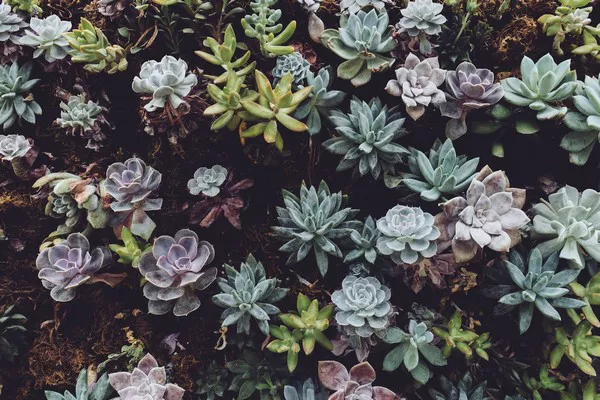Succulents, renowned for their striking and diverse appearances, are often associated with their ability to thrive in arid conditions. While many succulents are cherished for their intriguing forms and vibrant foliage, some species surprise with an added burst of color and delicate blossoms. In this article, we delve into the world of blooming succulents, exploring the wide array of species that exhibit this captivating trait and uncovering the secrets behind their enchanting flowers.
Succulents: Adaptation to Arid Environments
Succulents are a group of plants characterized by their ability to store water in their fleshy leaves, stems, or roots. This adaptation enables them to survive in regions with limited water availability, such as deserts and dry climates. Their unique physiology makes them not only resilient but also visually appealing, drawing the attention of plant enthusiasts and collectors worldwide.
Conditions Favoring Blooms
1. Sufficient Sunlight: While succulents are known for their hardiness, blooming often requires ample sunlight. Placing your succulents in areas with bright, indirect light or providing them with direct sunlight for a few hours each day can encourage flowering.
2. Temperature Fluctuations: Many succulents require distinct temperature fluctuations between day and night to trigger their blooming process. These fluctuations simulate their natural habitat and signal the plant to prepare for reproduction.
Succulent Varieties That Blossom
1. Echeveria
These rosette-forming succulents are beloved for their captivating hues and stunning symmetry. Echeverias produce tall, slender flower stalks adorned with bell-shaped blooms that come in shades of pink, orange, red, and yellow. Their elegant flowers create a striking contrast against their plump foliage.
2. Kalanchoe
Kalanchoes are known for their vibrant and long-lasting flower clusters. These succulents produce small, star-shaped blooms in an array of colors, including red, orange, yellow, and pink. Their ability to bloom profusely makes them a popular choice for indoor and outdoor gardens alike.
3. Sedum
Sedums, also known as stonecrops, encompass a wide range of succulent species that exhibit diverse growth habits and flower forms. Some sedums produce clusters of small, star-shaped flowers, while others boast larger, showier blooms. Their blooms can range from white to pink, red, and even bi-colored variations.
4. Crassula
Crassulas feature an assortment of captivating forms, from stacked varieties to those with unique leaf shapes. Their blossoms are typically small and delicate, often arranged in tight clusters or sprays. The flowers come in shades of white, pink, and pale yellow, enhancing the visual appeal of these succulents.
5. Aloe
Aloe plants are not only prized for their soothing gel but also for their impressive flower spikes. Aloe blooms are tubular and can vary in color, including vibrant shades of orange, red, and yellow. Their bold blossoms attract pollinators, adding an extra dimension to their allure.
Caring for Blooming Succulents
1. Appropriate Watering: While succulents are drought-tolerant, flowering succulents may require slightly more water during their blooming phase. Ensure that the soil is well-draining to prevent root rot, and allow the top inch of soil to dry out before watering again.
2. Fertilization: To support healthy flowering, use a balanced, low-nitrogen fertilizer during the growing season. Over-fertilization can lead to excessive foliage growth at the expense of flower production.
3. Pruning: After a succulent has finished flowering, consider pruning the spent flower stalks to direct the plant’s energy towards new growth and future blossoms.
Seasonal Blooms
1. Spring: Spring is a season of renewal, and many succulents take this opportunity to grace us with their colorful blooms. Echeverias, with their varied shades, and Kalanchoes, with their abundant clusters, are often spring bloomers.
2. Summer: Summer is a time when a variety of succulents, including many Sedum species, come alive with vibrant flowers. Their blooms attract pollinators and add a lively touch to gardens and landscapes.
3. Fall: As temperatures cool, some succulents, like certain Crassula varieties, may produce their charming blossoms. These blooms can extend the visual interest of your garden into the autumn months.
The Art of Propagation
1. Leaf Propagation: Many succulents can be propagated from leaves. Gently remove a healthy leaf and allow it to callous over before placing it on well-draining soil. With time, new growth will emerge, eventually leading to the formation of a new plant.
2. Offsets and Pups: Some succulents produce offsets or pups, which are smaller versions of the parent plant that grow at the base. These can be carefully separated and replanted to create new plants.
Conclusion
Succulents, renowned for their water-storing adaptations and captivating appearances, offer a world of beauty that extends beyond their foliage. The phenomenon of blooming succulents adds an extra layer of enchantment, showcasing the resilience and diversity of these plants. From the delicate bell-shaped blooms of Echeverias to the vibrant clusters of Kalanchoes, the world of blooming succulents invites us to appreciate the intricate wonders of nature’s design. By understanding the conditions and care required for these unique species, enthusiasts can create thriving gardens that come alive with color and charm, transforming arid landscapes into breathtaking oases of floral elegance.


